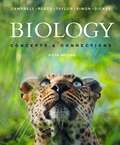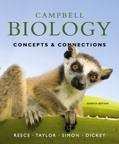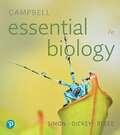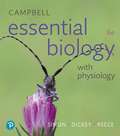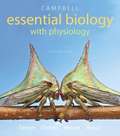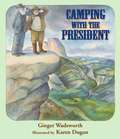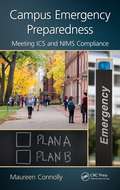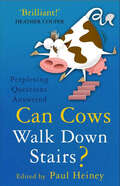- Table View
- List View
Campbell Biology: Concepts and Connections (6th edition)
by Eric J. Simon Jane B. Reece Neil A. Campbell Martha R. Taylor Jean L. DickeyThe aim of this book is to engage students from a wide variety of majors in the wonders of the living world. In this sixth edition the emphasis is on connections to our everyday world while also doing more to help students connect the concepts of biology to evolution.
Campbell Biology: Concepts and Connections (7th Edition)
by Eric J. Simon Jane B. Reece Martha R. Taylor Jean L. DickeyCampbell Biology: Concepts & Connections, Seventh Edition has undergone an extensive revision to make biology even more approachable with increased use of analogies, real world examples, and more conversational language.
Campbell Essential Biology
by Jane Reece Eric Simon Jean DickeyFor non-majors biology courses. <p><p>Develop and Practice Science Literacy Skills <p><p>Teach students to view their world using scientific reasoning with Campbell Essential Biology. The authors’ approach equips your students to become better informed citizens, relate concepts from class to their everyday lives, and understand and apply real data, making biology relevant and meaningful to their world and futures. <p><p>The new edition incorporates instructor feedback on what key skills to highlight in new Process of Science essays and uses striking infographic figures in conveying real data to help students see and better understand how science actually works. New author-narrated Figure Walkthrough Videos appear in each chapter and guide students through key biology concepts and processes.
Campbell Essential Biology (4th edition)
by Eric J. Simon Jane B. Reece Jean L. DickeyThe material in this Essential Biology, 4th edition is organized within four core areas: cells, genes, evolution, and ecology to help instructors and students focus on the most important areas of biology within a single semester.
Campbell Essential Biology (5th Edition)
by Eric J. Simon Jane B. Reece Jean L. DickeyCampbell Essential Biology, Fifth Edition makes biology interesting for non-major biology students. This best-selling book, known for its scientific accuracy and currency, makes biology relevant and approachable with increased use of analogies, real world examples, more conversational language, and intriguing questions.
Campbell Essential Biology With Physiology (Sixth Edition)
by Eric J. Simon Jane B. Reece Jean L. Dickey Rebecca A. BurtonHailed for its clear writing, scientific accuracy, and real-world examples,Essential Biology with Physiology is a brief non-majors biology text that focuses on the core concepts readers need to make scientifically informed decisions throughout their lives. The book covers four major topics-cells, genetics, evolution/diversity, and ecology-followed by nine chapters on animal and plant physiology. Human applications and the most up-to-date information on important issues show readers how biology relates to their own lives. <P><P>New Process of Science sections within the text draw readers into the material and provide real-world examples of how the scientific method is applied. <P><P>CELLS: Essential Chemistry for Biology, The Molecules of Life, A Tour of the Cell, The Working Cell, Cellular Respiration: Obtaining Energy from Food, Photosynthesis: Using Light to Make Food. <P><P>GENETICS: Cellular Reproduction: Cells from Cells, Patterns of Inheritance, The Structure and Function of DNA, How Genes are Controlled, DNA Technology. <P><P>EVOLUTION AND DIVERSITY: How Populations Evolve, How Biological Diversity Evolves, The Evolution of Microbial Life, Plants, Fungi, and the Move onto Land, The Evolution of Animals. <P><P>ECOLOGY: The Ecology of Organisms and Populations, Communities and Ecosystems, Human Impact on the Environment. <P><P>ANIMAL STRUCTURE AND FUNCTION: Unifying Concepts of Animal Structure and Function, Nutrition and Digestion, Circulation and Respiration , The Body's Defenses, Hormones, Reproduction and Development, Nervous, Sensory, and Motor Systems. <P><P>STRUCTURE AND FUNCTION: The Life of a Flowering Plant, The Working Plant. For all readers interested in a biology text that focuses on the core concepts readers need to make scientifically informed decisions throughout their lives.
Campbell Essential Biology with Physiology
by Eric J. Simon Jane B. Reece Jean L. DickeyCampbell Essential Biology with Physiology, Fourth Edition, makes biology irresistibly interesting for non-majors biology students. This best-selling book, known for its scientific accuracy and currency, makes biology relevant and approachable with increased use of analogies, real world examples, more conversational language, and intriguing questions. Campbell Essential Biology with Physiology ¦ make biology irresistibly interesting. This package contains: Campbell Essential Biology with Physiology, Fourth Edition
Campbell Essential Biology with Physiology
by Neil Campbell Jane Reece Eric Simon Jean Dickey Kelly HoganNIMAC-sourced textbook
Campbell Essential Biology with Physiology (5th Edition)
by Eric J. Simon Jane B. Reece Jean L. Dickey Kelly A. HoganCampbell Essential Biology makes biology interesting and understandable for non-majors biology students. This best-selling textbook, known for its scientific accuracy, clear explanations, and intuitive illustrations, has been revised to further emphasize the relevance of biology to everyday life, using memorable analogies, real-world examples, conversational language, engaging new Why Biology Matters photo essays, and more. New MasteringBiology activities engage students outside of the classroom and help students develop scientific literacy skills.
Campbell Essential Biology, Sixth Edition
by Eric J. Simon Jane B. Reece Jean L. Dickey Kelly A. HoganCampbell Essential Biology makes biology interesting and understandable for non-majors biology students. This textbook has been revised to further emphasize the relevance of biology to everyday life, using memorable analogies, real-world examples, conversational language, engaging new Why Biology Matters photo essays, and more. New Mastering Biology activities engage students outside of the classroom and help students develop scientific literacy skills.
Campbell's Atlas of Oil and Gas Depletion
by Alexander Wöstmann Colin J CampbellCampbell's Atlas of Oil and Gas Depletion, Second Edition, is the product of a half-century of critical analysis and updating of data on the status of oil and gas depletion by country, region and the world as a whole. Separate analyses of conventional and non-conventional oil and gas, which are depleting at different rates and costs, show when these critical energy sources peak and decline. The Atlas also summarizes the history and political circumstances of each country to assess the impact on oil and gas production and reserves. It contrasts the First Half of the Oil Age, which saw the rapid expansion of the world economy, allowing the population to grow six-fold, with the Second Half, which will witness a general contraction as these easy, high-density energy supplies dwindle. The transition threatens to be a time of great economic, financial and political tensions. The Atlas, which has been compiled and updated by prominent geologist, former oil company executive, and oil analyst Colin Campbell since the 1960s, addresses the need for a reliable and comprehensive database on a subject essential to governments, industry, academia, and the population as a whole as we attempt to adapt to these critically changing circumstances.
Camping with the President
by Ginger WadsworthShows how, while on a camping trip in 1903 with world-famous naturalist John Muir in Yosemite National Park, President Theodore Roosevelt formed his position on conservation, deciding to set aside new national parks and monuments to preserve wilderness lands for future generations.
Campus Emergency Preparedness: Meeting ICS and NIMS Compliance
by Maureen ConnollyAn easily digestible guide, Campus Emergency Preparedness: Meeting ICS and NIMS Compliance helps you develop and organize emergency operation plans. It incorporates the key components recommended by the Federal Emergency Management Agency (FEMA) and the US Department of Education and outlines the roles and responsibilities of campus personnel befor
Can America Remain Committed?: U.s. Security Horizons In The 1990s
by David G. HaglundThe twelve months that spanned the period between the early springtimes of 1991 and 1992 may well turn out to constitute the most important year for American foreign and security policy in half a century. Encasing the dawning of a new and different security era, like macabre parentheses, were two columns of black smoke-that of 1991 over the newly liberated Kuwait, and that of 1992 over the embattled district of South-Central Los Angeles. Within these acrid temporal brackets unfolded a set of developments of utmost significance for American foreign and security policy and for the very meaning of the country's external commitments.
Can Bacteria Cause Cancer?: Alternative Medicine Confronts Big Science
by David J. HessGrowing numbers of cancer patients are exploring diet, food supplements, herbs, and nontoxic immunotherapies like bacterial vaccines as a means of therapy. Yet most cancer research organizations refuse to even evaluate these alternatives. Can Bacteria Cause Cancer? argues convincingly that unless this neglected world of alternative therapies is properly scrutinized, the medical Vietnam of the twentieth century may well affect one in two people by the twenty-first century. David J. Hess investigates one of the great medical mysteries of the twentieth century-the relationship between bacteria and chronic disease. Recently scientists have overturned long-held beliefs by demonstrating that bacterial infections cause many ulcers; they are now reconsidering the role of bacterial infections in other chronic diseases, such as arthritis. Is it possible, Hess asks, that bacteria can contribute to the many other known causes of cancer? To answer this intriguing question, Hess takes us into the world of alternative cancer researchers. Maintaining that their work has been actively suppressed rather than simply dismissed, he examines their claims--that bacterial vaccines have led to some dramatic cases of long-term cancer remission-and the scientific potential of their theories. Economic interests and cultural values, he demonstrates, have influenced the rush toward radiation and chemotherapy and the current cul-de-sac of toxic treatments. More than a medical mystery story, Can Bacteria Cause Cancer? is a dramatic case study of the failure of the war on cancer.
Can Cows Walk Down Stairs?: Perplexing Questions Answered
by Paul HeineyWhat is ear wax for? Do bacteria have sex? How do they put stripes in toothpaste? Does your nose run in space? What are stars made of? This book answers those tantalising or perplexing questions for which you thought you'd never find an answer. A book for the naturally curious, as well as those seekers after scientific truths, it unravels both those things we take for granted, such as when you boil an egg, why does the yolk stay in the middle, or why is the sky blue, as well as questions which probe deeply, such as, what does an atom look like, or what was there before the beginning of time? if you were to write in the dust on the moon, how big would the letters have to be so you could see them from earth without a telescope? Drawing on the expertise of a team of enthusiastic scientists around the world, authoritative, entertaining, and often a touch humorous, it will appeal to anyone who's ever been curious about life on earth.
Can Fish Count?: What Animals Reveal About Our Uniquely Mathematical Minds
by Brian ButterworthAn entertaining investigation of the numerical abilities of animals and our own appetite for arithmetic The philosopher Bertrand Russell once observed that realizing that a pair of apples and the passage of two days could somehow both be represented by the concept we call &“two&” was one of the most astonishing discoveries anyone had ever made. So what do we make of the incredible fact that animals seem to have inherent mathematical abilities? As cognitive psychologist Brian Butterworth shows us in Can Fish Count?, many &“simple&” animals—such as bees, which count trees and fence posts, and guppies, which can size up groups—have a sense of numbers. And unlike humans, they don&’t need to be taught. In telling animals&’ stories, Butterworth shines new light on one of our most ancient questions: Just where, exactly, do numbers come from? He reveals how insights gleaned from studying animals can help us make better sense of our own abilities. Full of discovery and delight, Can Fish Count? is an astonishing journey through the animal kingdom and the human mind.
Can Fish Count?: What Animals Reveal about our Uniquely Mathematical Mind
by Brian Butterworth'What I like best about this fascinating book is the detail. Brian Butterworth doesn't just tell us stories of animals with numerical abilities: he tells us about the underlying science. Elegantly written and a joy to read' - Professor Ian Stewart, author of What's the Use? and Taming the Infinite'Full of thought-provoking studies and animal observations' - Booklist'Enlightening and entertaining' - Publishers WeeklyThe Hidden Genius of Animals: Every pet owner thinks their own dog, cat, fish or hamster is a genius. What makes CAN FISH COUNT? so exciting is the way it unveils just how widespread intelligence is in nature. Pioneering psychologist Brian Butterworth describes the extraordinary numerical feats of all manner of species ranging from primates and mammals to birds, reptiles, fish and insects. Whether it's lions deciding to fight or flee, frogs competing for mates, bees navigating their way to food sources, fish assessing which shoal to join, or jackdaws counting friends when joining a mob - every species shares an ability to count.Homo Sapiens may think maths is our exclusive domain, but this book shows that every creature shares a deep-seated Darwinian ability to understand the intrinsic language of our universe: mathematics CAN FISH COUNT? is that special sort of science book - a global authority in his field writing an anecdotally-rich and revelatory narrative which changes the way you perceive something we take for granted.
Can Fish Count?: What Animals Reveal about our Uniquely Mathematical Mind
by Brian ButterworthEvery pet owner thinks their own dog, cat, fish or hamster is a genius. What makes CAN FISH COUNT? so exciting is the way it unveils just how widespread intelligence is in nature. Pioneering psychologist Brian Butterworth describes the extraordinary numerical feats of all manner of species ranging from primates and mammals to birds, reptiles, fish and insects. Whether it's lions deciding to fight or flee, frogs competing for mates, bees navigating their way to food sources, fish assessing which shoal to join, or jackdaws counting friends when joining a mob - every species shares an ability to count.Homo Sapiens may think maths is our exclusive domain, but this book shows that every creature shares a deep-seated Darwinian ability to understand the intrinsic language of our universe: mathematics CAN FISH COUNT? is that special sort of science book - a global authority in his field writing an anecdotally-rich and revelatory narrative which changes the way you perceive something we take for granted.(P)2022 Quercus Editions Limited
Can Love Be Scientifically Proven?
by Lizzie WadeIs there a scientific explanation behind falling in love? Learn the answers from scientists who look into the physiology of romance.
Can Microbial Communities Regenerate?: Uniting Ecology and Evolutionary Biology (Convening Science: Discovery at the Marine Biological Laboratory)
by S. Andrew Inkpen W. Ford DoolittleBy investigating a simple question, a philosopher of science and a molecular biologist offer an accessible understanding of microbial communities and a motivating theory for future research in community ecology. Microorganisms, such as bacteria, are important determinants of health at the individual, ecosystem, and global levels. And yet many aspects of modern life, from the overuse of antibiotics to chemical spills and climate change, can have devastating, lasting impacts on the communities formed by microorganisms. Drawing on the latest scientific research and real-life examples such as attempts to reengineer these communities through microbial transplantation, the construction of synthetic communities of microorganisms, and the use of probiotics, this book explores how and why communities of microorganisms respond to disturbance, and what might lead to failure. It also unpacks related and interwoven philosophical questions: What is an organism? Can a community evolve by natural selection? How can we make sense of function and purpose in the natural world? How should we think about regeneration as a phenomenon that occurs at multiple biological scales? Provocative and nuanced, this primer offers an accessible conceptual and theoretical understanding of regeneration and evolution at the community level that will be essential across disciplines including philosophy of biology, conservation biology, microbiomics, medicine, evolutionary biology, and ecology.
Can Microbial Communities Regenerate?: Uniting Ecology and Evolutionary Biology (Convening Science: Discovery at the Marine Biological Laboratory)
by S. Andrew Inkpen W. Ford DoolittleBy investigating a simple question, a philosopher of science and a molecular biologist offer an accessible understanding of microbial communities and a motivating theory for future research in community ecology. Microorganisms, such as bacteria, are important determinants of health at the individual, ecosystem, and global levels. And yet many aspects of modern life, from the overuse of antibiotics to chemical spills and climate change, can have devastating, lasting impacts on the communities formed by microorganisms. Drawing on the latest scientific research and real-life examples such as attempts to reengineer these communities through microbial transplantation, the construction of synthetic communities of microorganisms, and the use of probiotics, this book explores how and why communities of microorganisms respond to disturbance, and what might lead to failure. It also unpacks related and interwoven philosophical questions: What is an organism? Can a community evolve by natural selection? How can we make sense of function and purpose in the natural world? How should we think about regeneration as a phenomenon that occurs at multiple biological scales? Provocative and nuanced, this primer offers an accessible conceptual and theoretical understanding of regeneration and evolution at the community level that will be essential across disciplines including philosophy of biology, conservation biology, microbiomics, medicine, evolutionary biology, and ecology.
Can Microbial Communities Regenerate?: Uniting Ecology and Evolutionary Biology (Convening Science: Discovery at the Marine Biological Laboratory)
by S. Andrew Inkpen W. Ford DoolittleBy investigating a simple question, a philosopher of science and a molecular biologist offer an accessible understanding of microbial communities and a motivating theory for future research in community ecology. Microorganisms, such as bacteria, are important determinants of health at the individual, ecosystem, and global levels. And yet many aspects of modern life, from the overuse of antibiotics to chemical spills and climate change, can have devastating, lasting impacts on the communities formed by microorganisms. Drawing on the latest scientific research and real-life examples such as attempts to reengineer these communities through microbial transplantation, the construction of synthetic communities of microorganisms, and the use of probiotics, this book explores how and why communities of microorganisms respond to disturbance, and what might lead to failure. It also unpacks related and interwoven philosophical questions: What is an organism? Can a community evolve by natural selection? How can we make sense of function and purpose in the natural world? How should we think about regeneration as a phenomenon that occurs at multiple biological scales? Provocative and nuanced, this primer offers an accessible conceptual and theoretical understanding of regeneration and evolution at the community level that will be essential across disciplines including philosophy of biology, conservation biology, microbiomics, medicine, evolutionary biology, and ecology.
Can Potatoes Feed the World? (Sustainable Development Goals Series)
by John E. BradshawBy 2050 the United Nations (UN) predicts a world population of 9.7 billion compared with 8 billion in 2022. Increases in food and energy production and the supply of fresh water will be needed to sustain this population, whilst reducing greenhouse gas emissions to limit global warming. The average global temperature is likely to be 2 to 3 degrees Celsius above that in pre-industrial times, unless there is a greater sense of urgency following the UN Climate Change Conference (COP26) in Glasgow in 2021, which still wanted to limit the rise to 1.5 degrees. There is also increasing concern about the loss of biodiversity on Earth from human activity, including farming, as seen in the outcomes of the UN Biodiversity Conference (COP15) in Montreal in 2022. More encouragingly, on 1 December 2023, 134 countries at COP28 in Dubai endorsed the landmark sustainable agriculture, resilient food systems and climate action declaration which put food systems transformation on the global climate agenda. &“While food systems are vital for meeting societal needs and enabling adaptation to climate impacts, they are also responsible for as much as a third of global greenhouse gas emissions.&” A warmer climate and loss of biodiversity will make life more difficult for humankind; but can potatoes at least help with food security? It is a scientific and technological question set in a political, economic and societal context. It has arisen because potatoes have made the journey from wild species to global food crop. The contribution of the potato to the United Nations Millennium Development Goals of providing food security and eradicating poverty was recognized when an International Year of the Potato 2008 (IYP 2008) was officially launched at the United Nations (UN) headquarters in New York on 18 October 2007 by the Director-General of FAO (Food and Agriculture Organization of the United Nations). Today the importance of potatoes can be seen in the context of the United Nations &“2030 Agenda for Sustainable Development&” which was adopted in 2015 and started on 1 January 2016. The agenda has 17 goals, the second of which (SDG2) is to end hunger, achieve food security and improved nutrition, and promote sustainable agriculture. By 2030, the aim of the agenda is to &‘ensure access by all people, in particular the poor and people in vulnerable situations, including infants, to safe, nutritious and sufficient food all year round&’. However, the projection in the 2023 Sustainable Development Goals Report was not zero-hunger but 600 million people still facing hunger. Hence a greater sense of urgency is required and also a need to look beyond 2030 to 2050. This book explores how potatoes can contribute to SDG2 by increasing potato production and improving the nutritional value of potatoes, in particular to alleviate micronutrient deficiencies (&‘hidden hunger&’), having first explained how potatoes became a major food crop and the lessons to be learnt from a major crop failure and resulting famine.
Can Princesses Become Astronauts? (Do Princesses)
by Carmela LaVigna CoyleDo princesses go on missions to Mars?Astronauts always reach for the stars.Do princesses grow up to be librarians?Teachers and Builders! And veterinarians!As the concluding volume in the Do Princesses…? Series, this book tells girls that the sky&’s the limit as to what they can achieve.
